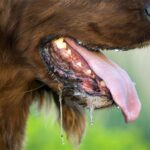Can Dogs Teeth Grow Back
Can Dogs Teeth Grow Back? The Surprising Truth About Canine Dental Health
If you’re a dog owner, you may have wondered at some point whether your furry friend’s teeth can grow back. Maybe you’ve noticed that your dog has lost a tooth or two, or has chipped or cracked teeth, and you’re concerned about the consequences for their health and happiness. Or maybe you’ve just heard some rumors or myths about canine dental care that sound too good to be true. Whatever your motivation, this article will provide you with the facts and insights you need to understand the complex and fascinating world of dog teeth.
First of all, let’s address the titular question: can dogs teeth grow back? The short answer is no, but it depends on what you mean by “teeth” and “grow back”. Unlike humans, dogs don’t have deciduous (baby) teeth that fall out and get replaced by permanent teeth. Instead, dogs have two sets of teeth in their lifetime: puppy teeth (also known as milk teeth or deciduous teeth) and adult teeth (also known as permanent teeth). Most dogs have 28 puppy teeth that start to erupt at around 3-4 weeks old and are fully grown by 8 weeks old. These puppy teeth are smaller and sharper than adult teeth, and are meant to help puppies chew soft food and play with toys before they can handle harder items.
However, just like human children, puppies will eventually lose their baby teeth as their adult teeth start to grow in. This process usually begins at around 3-4 months old and can take up to 7 months to complete. During this transition period, your puppy may experience some discomfort or pain from teething, which can make them more irritable or prone to biting or chewing on things they shouldn’t. You can help your puppy cope with teething by providing them with safe chew toys, cooling pads, or even frozen fruits or vegetables to chew on.
Once your puppy has grown all their adult teeth, they won’t get any more new teeth for the rest of their life. Adult dogs usually have 42 teeth, including incisors, canines, premolars, and molars. These teeth are larger, stronger, and more specialized than puppy teeth, and are designed to handle a wider range of food and activities. However, adult dogs are not immune to dental problems or injuries that can affect their teeth and gums. Some common issues that can arise include:
– Tooth decay: Just like human teeth, dog teeth can develop cavities or other forms of decay if they are exposed to bacteria and acid from food debris or plaque buildup. This can cause pain, infection, bad breath, and eventually tooth loss if left untreated.
– Gum disease: Also known as periodontal disease, this is a progressive condition that affects the tissues surrounding the teeth, including the gums, ligaments, and bone. Gum disease is caused by bacteria that thrive in the plaque and tartar on the teeth surfaces and lead to inflammation, bleeding, swelling, and receding gums. If gum disease is not treated in time, it can cause irreversible damage to the jawbone and lead to tooth loss.
– Trauma: Dogs can suffer from various types of trauma that can damage their teeth or jaws. For example, they may break a tooth by biting on something hard or getting hit by an object or vehicle. They may also fracture their jaw by falling from a height or fighting with another dog. Trauma can cause pain, bleeding, infection, and difficulty eating or drinking.
So what happens when a dog loses a tooth? Can it grow back? The answer is no in most cases. When a dog loses a tooth due to injury or disease, the tooth will not regenerate like some animals do (e.g., sharks or reptiles). The tooth socket may fill up with bone and gum tissue over time, but this will not result in a new tooth. However, some exceptions exist:
– Some dogs may have extra teeth that can compensate for the loss of one or more teeth. This is more common in breeds like Chihuahuas or Pomeranians, which are prone to dental anomalies.
– Some dogs may undergo dental procedures like root canal therapy or crown placement to save damaged teeth and preserve their function and appearance. These treatments require anesthesia and specialized veterinary care, so they can be expensive and risky.
– Some dogs may adapt to missing teeth by changing their eating habits or using their remaining teeth differently. For example, a dog that loses a front tooth may start chewing with their molars instead.
Overall, it’s important to take good care of your dog’s dental health from an early age and throughout their life. This includes regular brushing with dog-specific toothpaste, providing chew toys and bones that are safe for your dog’s size and age, avoiding feeding them table scraps or sugary snacks, and scheduling routine dental checkups with your vet. By doing so, you can help prevent dental problems from developing or worsening, improve your dog’s overall well-being, and avoid the need for costly or painful dental treatments down the road.
In conclusion, while dogs’ teeth cannot grow back like magic, there are many ways you can support your dog’s dental health and happiness as a responsible owner. Whether you have a puppy that is teething or an adult dog that needs some TLC on their teeth, remember that prevention is key and that every dog deserves a healthy smile. And who knows? Maybe someday scientists will discover a way to regrow dog teeth after all – stranger things have happened!



